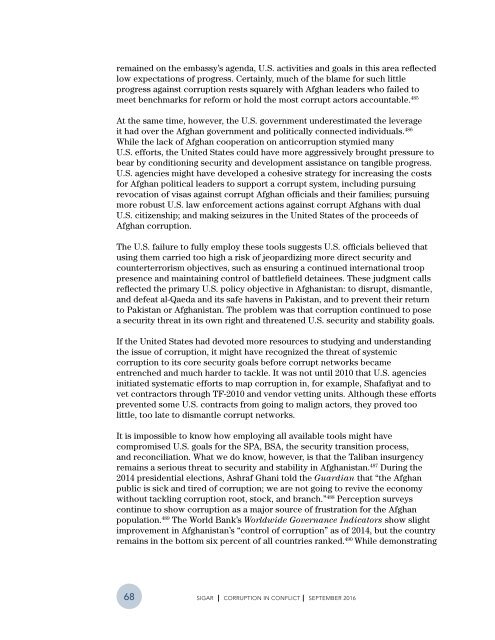CORRUPTION IN CONFLICT
5IlaWjQej
5IlaWjQej
You also want an ePaper? Increase the reach of your titles
YUMPU automatically turns print PDFs into web optimized ePapers that Google loves.
emained on the embassy’s agenda, U.S. activities and goals in this area reflected<br />
low expectations of progress. Certainly, much of the blame for such little<br />
progress against corruption rests squarely with Afghan leaders who failed to<br />
meet benchmarks for reform or hold the most corrupt actors accountable. 485<br />
At the same time, however, the U.S. government underestimated the leverage<br />
it had over the Afghan government and politically connected individuals. 486<br />
While the lack of Afghan cooperation on anticorruption stymied many<br />
U.S. efforts, the United States could have more aggressively brought pressure to<br />
bear by conditioning security and development assistance on tangible progress.<br />
U.S. agencies might have developed a cohesive strategy for increasing the costs<br />
for Afghan political leaders to support a corrupt system, including pursuing<br />
revocation of visas against corrupt Afghan officials and their families; pursuing<br />
more robust U.S. law enforcement actions against corrupt Afghans with dual<br />
U.S. citizenship; and making seizures in the United States of the proceeds of<br />
Afghan corruption.<br />
The U.S. failure to fully employ these tools suggests U.S. officials believed that<br />
using them carried too high a risk of jeopardizing more direct security and<br />
counterterrorism objectives, such as ensuring a continued international troop<br />
presence and maintaining control of battlefield detainees. These judgment calls<br />
reflected the primary U.S. policy objective in Afghanistan: to disrupt, dismantle,<br />
and defeat al-Qaeda and its safe havens in Pakistan, and to prevent their return<br />
to Pakistan or Afghanistan. The problem was that corruption continued to pose<br />
a security threat in its own right and threatened U.S. security and stability goals.<br />
If the United States had devoted more resources to studying and understanding<br />
the issue of corruption, it might have recognized the threat of systemic<br />
corruption to its core security goals before corrupt networks became<br />
entrenched and much harder to tackle. It was not until 2010 that U.S. agencies<br />
initiated systematic efforts to map corruption in, for example, Shafafiyat and to<br />
vet contractors through TF-2010 and vendor vetting units. Although these efforts<br />
prevented some U.S. contracts from going to malign actors, they proved too<br />
little, too late to dismantle corrupt networks.<br />
It is impossible to know how employing all available tools might have<br />
compromised U.S. goals for the SPA, BSA, the security transition process,<br />
and reconciliation. What we do know, however, is that the Taliban insurgency<br />
remains a serious threat to security and stability in Afghanistan. 487 During the<br />
2014 presidential elections, Ashraf Ghani told the Guardian that “the Afghan<br />
public is sick and tired of corruption; we are not going to revive the economy<br />
without tackling corruption root, stock, and branch.” 488 Perception surveys<br />
continue to show corruption as a major source of frustration for the Afghan<br />
population. 489 The World Bank’s Worldwide Governance Indicators show slight<br />
improvement in Afghanistan’s “control of corruption” as of 2014, but the country<br />
remains in the bottom six percent of all countries ranked. 490 While demonstrating<br />
68<br />
SIGAR I <strong>CORRUPTION</strong> <strong>IN</strong> <strong>CONFLICT</strong> I SEPTEMBER 2016


